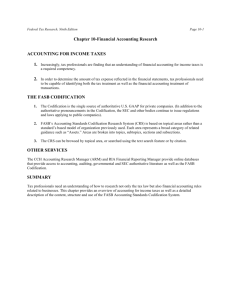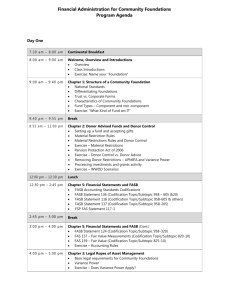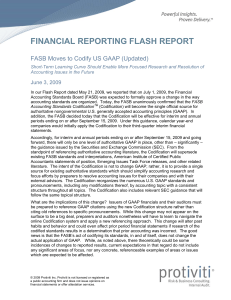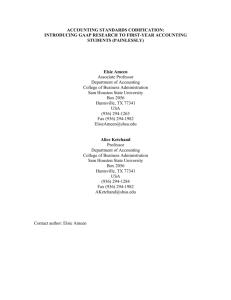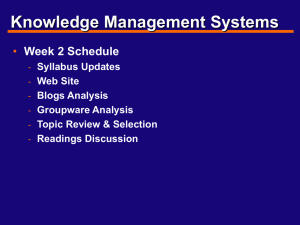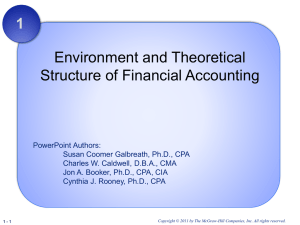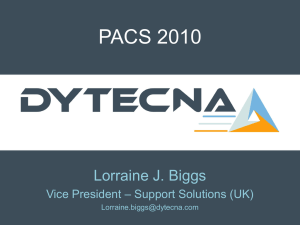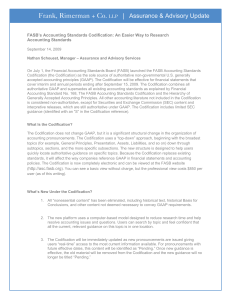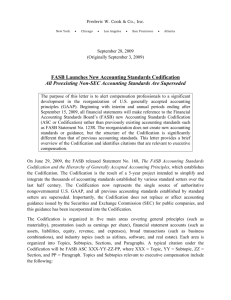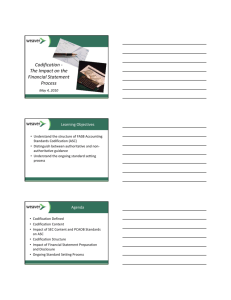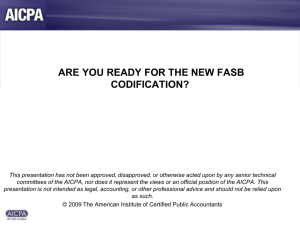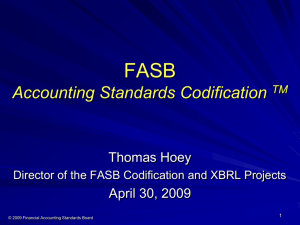Understanding_and_Working_with_the_new_FASB_Codification
advertisement
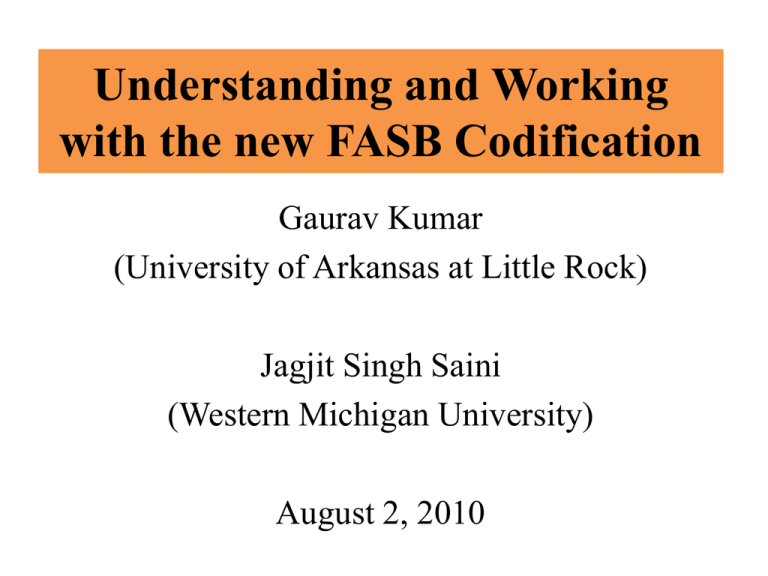
Understanding and Working with the new FASB Codification Gaurav Kumar (University of Arkansas at Little Rock) Jagjit Singh Saini (Western Michigan University) August 2, 2010 Objectives of Codification • Simplify user access to US GAAP by rearranging GAAP literature (not change GAAP). • Ensure that codified content accurately represents authoritative US GAAP as of July 1, 2009. • Create up to date codification research system. Structure Old: Classified by hierarchical levels (A through D) and organized by standards, interpretations, and related guidance. New: Classified by topics and only two levels (authoritative and nonauthoritative). Contains both FASB standards and SEC content. SEC content applies only to SEC registrants. Topical (Menu) Structure of New Codification 9 Areas 100’s: General Principles 200’s: Presentation 300’s: Assets 400’s: Liabilities 500’s: Equity 600’s: Revenue 700’s: Expenses 800’s: Broad Transactions 900’s: Industry Overview of GAAP General Presentation matters 90 Topics XXX Subtopics XXX-YY Deals with transactions unique to specific industries or types of activities 16 Sections/ Subsections XXX-YY-ZZ Paragraphs Structure Contd… - An Example Debt: ASC 470 TOPIC SUBTOPICS Overall (470-10) Debt with conversion and other options (470-20) SECTIONS/ SUBSECTIONS Scope 470-10-15 Subsequent Measurements 470-10-35 PARAGRAPHS General Entities 470-10-15-1 Participating Mortgage Loans (470-30) Disclosure 470-10-50 General Transactions 470-10-15-2 NOTE: This is for illustration purpose only and does not include all topics, subtopics, sections and subsections. Structure Contd… Topics: Topics represent a collection of related guidance. For example, Debt is a topic under the area Liabilities representing ASC 470. Each area is divided into different topics: General Principles: 1 topic Presentation: 15 topics Assets: 9 topics Liabilities: 9 topics Equity: 1 topic Revenue: 1 topic Expenses: 8 topics Broad Transactions: 14 topics Industries: 32 topics Structure Contd… Subtopics: Are subsets of topics generally distinguished by type and scope. For Example, ‘Debts with Conversion and Other Options’ and ‘Participating Mortgage Loans’ are two subtopics under the topic ‘Debt’ distinguished by type of debt. Each topic has an ‘Overall’ subtopic representing overall guidance. Structure Contd… Sections: Represent nature of content in a subtopic such as Recognition, Measurement, Disclosure, etc. Each subtopic is divided into 16 sections as shown on next slide. If there is no content for a section then the section will not display. Structure Contd…(16 Sections) • XXX-YY-00 Status • XXX-YY-05 Overview and Background • XXX-YY-10 Objectives • XXX-YY-15 Scope and Scope Exceptions • XXX-YY-20 Glossary • XXX-YY-25 Recognition • XXX-YY-30 Initial Measurement • XXX-YY-35 Subsequent Measurement • XXX-YY-40 Derecognition • XXX-YY-45 Other Presentation Matters • XXX-YY-50 Disclosure • XXX-YY-55 Implementation Guidance and Illustrations • XXX-YY-60 Relationships • XXX-YY-65 Transition and Open Effective Date Information • XXX-YY-70 Grandfathered Guidance • XXX-YY-75 XBRL Definitions Structure Contd… Subsections: Are further segregation of a section and occur in a limited number of cases only (except General Subsection). A subsection is not numbered. Paragraph/ Paragraph Groups: Actual topical content is located at paragraph level. Paragraph group represents a series of related paragraphs under same paragraph heading. New Classification System FASB uses a hybrid classification system for the Codification. Structure of classification looks like: XXX-YY-ZZ-PP where, XXX represents Topic, YY represents Subtopic, ZZ represents Section, PP represents Paragraph In case of a ‘SEC Content’, an “S” precedes the section number. Update Process Old: Issue different kinds of pronouncements to update GAAP (statement, interpretations, staff positions, abstracts, etc.) New: FASB update using only one type of pronouncement – an “Accounting Standard Update” (ASU). Each ASU is numbered sequentially within each calendar year (e.g. 2009-01, 2009-02,…) and specifies how authoritative codification standards are to be updated and contains an appendix/section with new or revised Codification language. When FASB issues an ASU, the central database is updated for all users of Codification Online Research System so that the update can be seen immediately and simultaneously. Benefits of Codification Reduce the amount of time and effort required to research and solve an accounting issue. Improve the usability of literature and reduce the risk of noncompliance. Provide accurate information as real-time updates as Accounting Standard Updates are released. Assist FASB with research and convergence efforts. Eliminates redundancy. Academics and Codification Accounting Standards Codification makes the work of academicians easier in teaching accounting research to the students. Use of accounting case studies is a common method to train the students in accounting research. How does Codification help accomplish this task? Codification reduces the time and effort required by students in solving the case studies. Reduces the complexity in locating the appropriate GAAP literature for problem solving. Simplifies search strategies for problem solving. Strategy for Accounting Research Students in using the Codification for solving Accounting Cases Identify the key issue(s) of the case to be explored. Identify the codification area to which key issue(s) belong(s) to. Identify the relevant topic under the area. Identify the relevant subtopics, sections, and/or subsections. Explore the relevant paragraph(s) addressing the issue(s). An Example ISSUE: Identification of Operating segments of a public entity for Segment Reporting under SFAS 131. SOLUTION: Issue is related to presentation of segment information on financial statements. Area: Presentation Topic 280: Segment Reporting (ASC 280) Subtopic 10: Overall (ASC 280-10) Section 55: Implementation guidance and illustrations (ASC 280-10-55) Paragraph 26: Diagram for identifying reportable operating segments (ASC 280-10-55-26) Accessing the Codification Website: http://asc.fasb.org User login: Basic View (Free) Professional View (Fee-based) • Individual access for $850 annually. • Professional View is available to Accounting Faculty and Students for free via the Academic Accounting Access Program for a small annual administrative fee of $150 to be paid by the institution. Institutions can enroll using the following link to the enrollment form: https://aaahq.org/AAAforms/FASB/enroll.cfm References 1. McEwen, R. A., T. J. Hoey, and J. A. Brozovsky. 2006. The FASB’s codification project: A critical step toward simplification. Accounting Horizons 20 (Dec.): 391-398. 2. Pounder, B. 2009. Keeping up with the FASB Codification. Strategic Finance (Oct.): 17 3. http://asc.fasb.org
